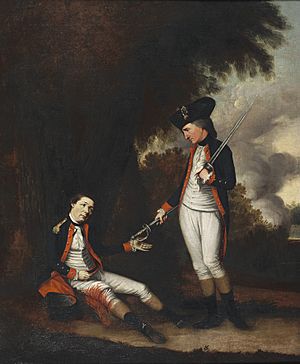Battle of Stono Ferry facts for kids
Quick facts for kids Battle of Stono Ferry |
|||||||
|---|---|---|---|---|---|---|---|
| Part of the American Revolutionary War | |||||||
 The Death of Colonel Owen Roberts by Henry Benbridge |
|||||||
|
|||||||
| Belligerents | |||||||
| Commanders and leaders | |||||||
| Benjamin Lincoln | John Maitland | ||||||
| Strength | |||||||
| 1,500 militia 6 artillery pieces |
900 infantry | ||||||
| Casualties and losses | |||||||
| 34 killed 113 wounded 155 missing |
26 killed 93 wounded 1 missing |
||||||
The Battle of Stono Ferry was a fight during the American Revolutionary War. It happened on June 20, 1779, near Charleston, South Carolina. In this battle, a group of British soldiers fought against American forces. The British were retreating from an attempt to capture Charleston. They were able to stop an attack by American militia (citizen soldiers) led by General Benjamin Lincoln.
Contents
Why the Battle Happened
British Plans in the South
The British wanted to regain control of their American colonies. Their plan for the southern colonies began in 1776. They tried to attack Charleston, South Carolina, but failed. This was a big defeat for the British Navy.
However, in December 1778, the British captured Savannah, Georgia. This made Charleston, South Carolina, vulnerable again. Charleston was an important city. It was the headquarters for the Continental Army in the South. General Benjamin Lincoln was in charge there.
Moving Forces and Retreats
In early 1779, General Lincoln's army grew stronger. He had soldiers from the Continental Army and local militia. He also had militia from North Carolina and Georgia. Lincoln used these forces to watch important areas near the Savannah River.
By mid-April, Lincoln felt ready to move. He wanted to surround the British in Savannah. He didn't know that the British were running low on supplies. American ships had captured many British supply ships.
Lincoln's move left the rich coastal areas of South Carolina unprotected. British General Augustine Prevost saw this as a chance to attack. On April 29, he marched out with 2,500 men. He aimed for the American militia at Purrysburg.
The American militia, about 1,000 men, were led by General William Moultrie. They decided to retreat towards Charleston instead of fighting Prevost. As Moultrie's forces fell back, many local men left to protect their homes. Prevost chased Moultrie all the way to Charleston.
British Retreat from Charleston
On May 10, there was a small fight near Ashley Ferry. This was about seven miles from Charleston. Two days later, Prevost learned that General Lincoln was quickly returning to Charleston. Prevost decided to retreat.
His army was moving slowly because they had taken many supplies. So, he left a group of soldiers behind at Stono Ferry. This spot was between Johns Island and the mainland. Most of his army left for Savannah by boat on June 16.
Prevost put Lieutenant Colonel John Maitland in charge of the soldiers left behind. This group had about 900 men. They built strong defenses. These included three redoubts (small forts) surrounded by an abatis (a barrier of sharpened logs). Soldiers from Scotland, Germany (Hessians), and American Loyalists manned these defenses.
Lincoln's Plan to Attack
When General Lincoln arrived in Charleston, he decided to attack the British outpost at Stono Ferry. Even though he had thousands of soldiers, he could only gather about 1,200 men for the attack. Most of these were local militia who were not well trained.
Lincoln's troops marched eight miles through the night. They arrived at dawn and had to move through thick woods. The Americans attacked in two main groups. General Jethro Sumner led the Carolina militia on the right. General Isaac Huger led the Continental Army troops on the left.
The Battle Begins
The battle started well for the Americans. They fired their small guns and cannons at the British for an hour. Then, they moved forward towards the British defenses.
Some of the Scottish soldiers fought until only a few were left. A German (Hessian) group also broke apart. At this point, Lieutenant Colonel Maitland moved his soldiers to fight Huger's group, which was a bigger threat.
The Hessians regrouped and returned to the fight. More British soldiers were brought across the bridge as backup. General Lincoln then decided to order his troops to pull back.
One notable event was when William Brothertin, a North Carolina militiaman, cut off a British officer's head with a sword. He later left the officer's hat to his son in his will.
After the Battle
The American forces lost 34 soldiers killed, 113 wounded, and 155 missing. Among those who died was Hugh Jackson, the older brother of future President Andrew Jackson. Hugh died from heat and exhaustion after being badly wounded.
The British lost 26 soldiers killed, 93 wounded, and 1 missing.
Lieutenant Colonel Maitland had already planned to leave Stono Ferry before the battle. His move was delayed because he didn't have enough boats. He finally began moving his troops on June 23 towards Beaufort. Lincoln's attack didn't really force him to move, it just happened around the same time.
You can still see the battle site today. It is at the end of South Carolina Route 318 near Rantowles.
Images for kids



